Abstract
Microplastics and nanoplastics are pervasive in the environment and pollute every tissue in the body. Emerging research demonstrates a positive correlation between tissue concentrations of microplastics and several common diseases. The sources of exposure are well understood and can be controlled. However, there appear to be no clinical trials for eliminating microplastics from tissues.
Introduction
Microplastics are generally recognized as particles ranging from 0.1 μm to 5 mm in diameter. Those smaller than 0.1 μm are defined as nanoplastics. In this editorial, the term microplastic is used to refer to both forms. Microplastics are ubiquitous environmental contaminants affecting all humans—in fact, all life on the planet. Humans are exposed through ingestion, inhalation, and dermal contact.
Translocation of microplastics across protective membranes and into human tissues is hugely impacted by particle size (smaller particles are more easily absorbed and translocated into tissues), surface charge (charged particles are more easily absorbed), and type of plastic (hugely variable). Microplastics can penetrate the intestinal, blood, blood-brain, and placental barriers. They pass through the cell membrane and enter the cytoplasm and even the mitochondria.
Table 1 summarizes the typical daily exposure in human adults. Clearly, exposure is ubiquitous.
Table 1.
| Ingestion | 4.88-5.77 × 105 microplastics/year |
| Salt | 5.00-7.00 × 103 |
| Fish | 0.50-1.20 × 104 |
| Fruits | 4.48-4.62 × 105 |
| Vegetables | 2.96-9.55 × 104 |
| Drinking water | 0.22-1.2 × 106 |
| Bottled water | 2.40 × 105 particles/L |
| Inhalation | 0.21-2.51 × 106 |
| Indoor | 0.16-2.30 × 106 |
| Outdoor | 0.46-2.10 × 105 |
Microplastics have been detected throughout the body: in the placenta, meconium, breast milk, lung, intestine, liver, kidney, heart and cardiovascular system, blood, urine, and cerebrovascular tissue. Microplastics have even been identified in uterine and testicular tissue.3
Figure 1 illustrates well how widely these particles are distributed throughout the body. Figure 1 estimates the most common microplastics types and the amount of exposure per day or concentration found in each tissue. Refer to Pizzorno’s editorial Safety of Plastic Food Containers (IMCJ 23.2) for a discussion of the health effects of each of the plastics types. All of the plastics types listed in Figure 1 are found in plastic food and water containers. Clearly, consuming food or liquids from plastic containers results in exposure to microplastics as well as their constituent chemicals.
Figure 1.
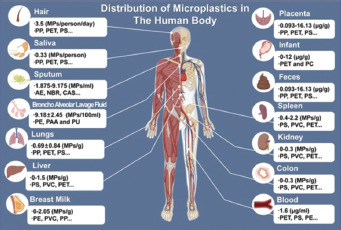
Microplastics Distribution in the Body1
Clinical Impact
The mechanisms by which microplastics cause disease are still being elicited. At this time, most of the toxicological studies of microplastics on humans are based on animal research (typically rodents, which have far better detoxification systems than humans) and human-derived cells.4 Microplastics appear to cause damage by slowly leaking their chemical constituents into surrounding tissues. Their contained chemicals—not just the monomers used to create the plastics but also the thousands of other chemicals found in plastics, as discussed in editorial 23.2—are diverse, which helps to explain the huge variations of effects found in the research.
Table 2 lists the damaging physiological effects of microplastics. The list is long and diverse. Essentially, all metabolic functions are affected. The underlying mechanism appears to be disruption of mitochondrial function, but there are plenty of examples of direct toxicity to tissues, such as to ovaries and spermatozoa, resulting in loss of fertility.5,6
Table 2.
The Diverse Physiological Effects of Microplastics7
| Lipid peroxidation |
| DNA damage |
| Activation of mitogen-activated protein kinase pathways |
| Cell membrane breakages |
| Mitochondrial dysfunction |
| Lysosomal defects that inhibit microplastics excretion from cells |
| Inflammation |
| Apoptosis |
| Atheroma and increased risk of cardiovascular events |
| Lung inflammation |
| Liver fibrosis |
| Gut dysbiosis |
Studies have attempted to estimate the contribution of microplastics to specific human diseases. Below is a representative list.
Atheromas and Cardiovascular Disease
A recent study on microplastics and atheromas has received a lot of attention, for good reason.8 This prospective, multicenter, observational trial studied patients with asymptomatic carotid artery disease. Microplastics were detected in excised carotid artery plaques. Specifically, polyethylene was detected in 58.4% of patients, and polyvinyl chloride was detected in 12.1% of patients. With a mean follow-up of 34 months, patients with microplastics in their atheromas were at a worrisome 4.5-fold higher risk for a primary cardiac end-point event than those without.
Inflammatory Bowel Disease
Microplastics concentrations in feces positively correlate with inflammatory bowel disease status.9 Patients with inflammatory bowel disease and fecal microplastics had 41.8 items/g dm (dry matter), significantly higher than the 28.0 items/g dm found in healthy people. The researchers detected 15 types of microplastics in feces, with polyethylene terephthalate (22.3%-34.0%) and polyamide (8.9%-12.4%) the most common.
Liver Disease
A small study measured microplastics in liver tissue of patients with and without liver disease. Patients with cirrhosis of the liver had 6 different microplastics polymers ranging from 4 to 30 μm in size, while no microplastics were found in patients with no liver disease.10
Sources
There are many sources of microplastics exposure, such as food containers (as discussed in IMCJ 23.2) and the vast plastic waste contamination of food, water, air, and health and beauty products. Figure 2 attempts to quantify the sources. Even table salt is contaminated!
Figure 2.
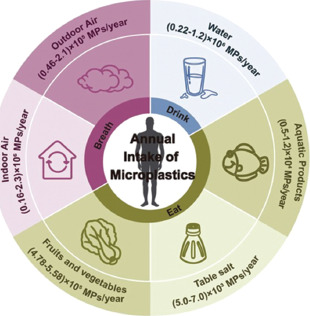
Sources of Microplastics1
Microplastics are found in humans in many forms: fibers, microbeads, fragments, nurdles, and Styrofoam, as shown in Figure 3.
Figure 3.
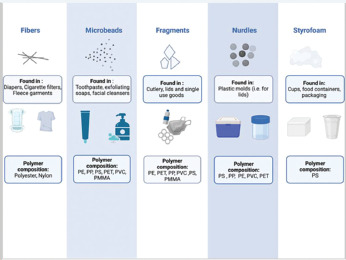
Physical Forms of Microplastics11
Figure 4 shows the primary sources of microplastics. Clearly, according to this study, plastic water containers are a substantial source of microplastics. As can be seen from these figures and tables, there is significant variation among studies trying to determine the amount and route of exposure to microplastics.
Figure 4.
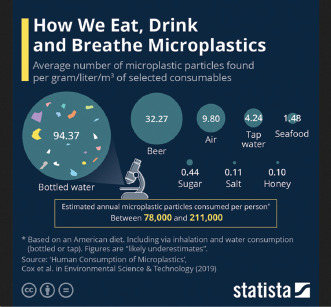
Primary Sources of Microplastics12
Another source of microplastics is take-out food containers. A study in China found 3 to 29 items/container.13 I found it particularly interesting that the authors reported that the microplastics came not only from flakes from containers’ surfaces but also from atmospheric fallout. The more the containers were flexed, the more microplastics were released. They also found that polystyrene containers released the most microplastics.
Inexplicably not well addressed in the preceding figures is the plastics found in air and dust. Figure 5 shows substantial amounts of microplastics are detected in dust. Especially worrisome is that many other chemicals are found in dust.
Figure 5.
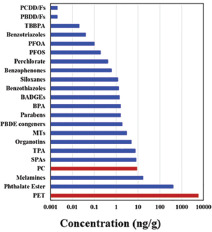
Chemicals and Microplastics in House Dust.14
Assessment
As can be seen in Figure 6, microplastics are measurable in the blood, and concentrations vary hugely by person and type of plastic. Unfortunately, we were unable to find a clinical laboratory that measures microplastics in any tissue or fluid.
Figure 6.
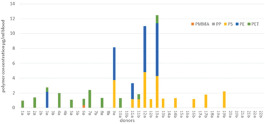
Microplastics in Human Blood15
We are in conversation with a laboratory that is considering measuring microplastics concentrations in stool. However, the correlation of stool levels of microplastics with blood and tissue levels is unclear. Stool assessment appears to be useful. In addition to the correlation with inflammatory bowel disease noted above, correlation has also been found in other diseases such as aortic calcification.16
Intervention
There is considerable environmental remediation research, especially aquatic, showing several ways to decrease microplastics levels. There is some intriguing animal research looking at strategies such as probiotics to improve mucosal integrity and agents such as chlorella (a nutritional algae) and activated charcoal to bind microplastics in the gut. However, we could not find any clinical trials studying how to increase microplastics elimination in humans. At this time all we can advise with confidence is decreasing exposure, improving gut mucosal integrity, and using binding agents like fiber (and chlorella and activated charcoal) to prevent absorption from the gut.
Putting together the takeaways from Pizzorno’s Safety of Plastic Food Containers editorial and the tables and figures above, clearly, the less exposure to plastics the better. Since plastic bottles appear to be the largest source of microplastics, other containers must be used. The obvious options are metal and glass. We tested several water containers as part of an ongoing detoxification for diabetes project by Pizzorno and colleagues (a report will be provided in the future, but a teaser: decreasing body load of diabetogenic metals and chemicals improves blood sugar control). Because arsenic is a contributor to diabetes,17we used ZeroWater filtration to clean the water, since this process effectively removes arsenic.18 ZeroWater provides with the filtration units a clever device that measures total dissolved solids to demonstrate the efficacy of their filters. As you might expect, comparing tap water with high levels of total dissolved solids with pure water after filtration was very compelling to the participants. We then happened to test the water again after it was put into the various “clean/green” containers that the participants had been using. We want to be very clear that this was not a controlled study and in no way should be interpreted as conclusive. Also, there is a bit of controversy with this water purifier since Consumer Reports asserts it leaks some microplastics into the filtered water. Nonetheless, we found that all the metal water containers increased total dissolved solids while all the glass ones did not. We, of course, do not know what the metal containers were leaching into the water, but we expected to find nothing. Clearly, we need to stop using plastic water bottles and use glass instead.
Conclusions
Every human in the world has microplastics throughout their body. Their tissue concentrations of microplastics correlate with the amount of exposure to plastics, such as are found in food containers, air, water, and health and beauty products. At this time, it appears the most effective ways to decrease microplastics exposure are to avoid using plastic food containers and, especially, plastic water bottles, filter all drinking water, and filter the air.
Biographies
Lyn Patrick, ND, is a licensed naturopathic physician, global speaker and trainer. She is the Medical Director of EMEI Global (emeiglobal.com) and teaches environmental medicine to healthcare providers through the EMEI platform.

Joseph Pizzorno, ND, Editor in Chief, IMCJ; co-author, Textbook of Natural Medicine; Founding President, Bastyr University; Member, Board of Directors, Institute for Functional Medicine.
References
- 1.Yang Z, Wang M, Feng Z, et al. Human microplastics exposure and potential health risks to target organs by different routes: a review. Curr Pollut Rep. 2023;9(3):468-485. doi:10.1007/s40726-023-00273-8 [Google Scholar]
- 2.Qian N, Gao X, Lang X, et al. Rapid single-particle chemical imaging of nanoplastics by SRS microscopy. Proc Natl Acad Sci USA. 2024;121(3):e2300582121. doi:10.1073/pnas.2300582121 [DOI] [PMC free article] [PubMed] [Google Scholar]
- 3.Hong Y, Wu S, Wei G. Adverse effects of microplastics and nanoplastics on the reproductive system: A comprehensive review of fertility and potential harmful interactions. Sci Total Environ. 2023;903:166258. doi:10.1016/j.scitotenv.2023.166258 [DOI] [PubMed] [Google Scholar]
- 4.Sun A, Wang W. Human exposure to microplastics and its associated health risks. Environ Health. d [Google Scholar]
- 5.Jin H, Ma T, Sha X, et al. Polystyrene microplastics induced male reproductive toxicity in mice. J Hazard Mater. 2021;401:123430. doi:10.1016/j.jhazmat.2020.123430 [DOI] [PubMed] [Google Scholar]
- 6.Hou J, Lei Z, Cui L, et al. Polystyrene microplastics lead to pyroptosis and apoptosis of ovarian granulosa cells via NLRP3/Caspase-1 signaling pathway in rats. Ecotoxicol Environ Saf. 2021;212:112012. doi:10.1016/j.ecoenv.2021.112012 [DOI] [PubMed] [Google Scholar]
- 7.Kadac-Czapska K, Ośko J, Knez E, Grembecka M. Microplastics and oxidative stress—current problems and prospects. Antioxidants. 2024;13(5):579. doi:10.3390/antiox13050579 [DOI] [PMC free article] [PubMed] [Google Scholar]
- 8.Marfella R, Prattichizzo F, Sardu C, et al. Microplastics and nanoplastics in atheromas and cardiovascular events. N Engl J Med. 2024;390(10):900-910. doi:10.1056/NEJMoa2309822 [DOI] [PMC free article] [PubMed] [Google Scholar]
- 9.Yan Z, Liu Y, Zhang T, Zhang F, Ren H, Zhang Y. Analysis of microplastics in human feces reveals a correlation between fecal microplastics and inflammatory bowel disease status. Environ Sci Technol. 2022;56(1):414-421. doi:10.1021/acs.est.1c03924 [DOI] [PubMed] [Google Scholar]
- 10.Horvatits T, Tamminga M, Liu B, et al. Microplastics detected in cirrhotic liver tissue. EBioMedicine. 2022;82:104147. doi:10.1016/j.ebiom.2022.104147 [DOI] [PMC free article] [PubMed] [Google Scholar]
- 11.Zurub RE, Cariaco Y, Wade MG, Bainbridge SA. Microplastics exposure: implications for human fertility, pregnancy and child health. Front Endocrinol (Lausanne). 2024;14:1330396. doi:10.3389/fendo.2023.1330396 [DOI] [PMC free article] [PubMed] [Google Scholar]
- 12.Armstrong M. How we eat, drink, and breathe microplastics. Statista. December 2022. Accessed Aug 28, 2024. https://www.statista.com/chart/18299/how-we-eat-drink-and-breathe-microplastics
- 13.Du F, Cai H, Zhang Q, Chen Q, Shi H. Microplastics in take-out food containers. J Hazard Mater. 2020;399:122969. doi:10.1016/j.jhazmat.2020.122969 [DOI] [PubMed] [Google Scholar]
- 14.Kannan K, Vimalkumar K. A review of human exposure to microplastics and insights into microplastics as obesogens. Front Endocrinol (Lausanne). 2021;12:724989. doi:10.3389/fendo.2021.724989 [DOI] [PMC free article] [PubMed] [Google Scholar]
- 15.Leslie HA, van Velzen MJM, Brandsma SH, Vethaak AD, Garcia-Vallejo JJ, Lamoree MH. Discovery and quantification of plastic particle pollution in human blood. Environ Int. 2022;163:107199. doi:10.1016/j.envint.2022.107199 [DOI] [PubMed] [Google Scholar]
- 16.Yan J, Pan Y, He J, et al. Toxic vascular effects of polystyrene microplastic exposure. Sci Total Environ. 2023;905:167215. doi:10.1016/j.scitotenv.2023.167215 [DOI] [PubMed] [Google Scholar]
- 17.Pizzorno J. Time to recognize and address the serious arsenic problem. Integr Med (Encinitas). 2024;23(1):6-9. [PMC free article] [PubMed] [Google Scholar]
- 18.Barnaby R, Liefeld A, Jackson BP, Hampton TH, Stanton BA. Effectiveness of table top water pitcher filters to remove arsenic from drinking water. Environ Res. 2017;158:610-615. doi:10.1016/j.envres.2017.07.018 [DOI] [PMC free article] [PubMed] [Google Scholar]


